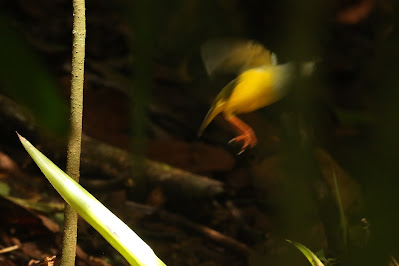For many, the Resplendent Quetzal Pharomachrus mocinno is the poster bird for Costa Rican eco-tourism, the undoubted number one. Clad in vivid, metallic green plumage with an unfeasibly long tail dangling below, the male quetzal is high on the tick list of tourists and birders alike. And it's a more dramatic bird than my dodgy photograph (above) might suggest, although the sight of this luminous male glimpsed through a gap in the foliage was an exciting moment.
While Costa Rica may be the best place to see one, the Resplendent Quetzal occurs along the spine of Central America from the south of Mexico to western Panama. In Guatemala it has given its name to the national currency, the story being that in the days of Mayan civilisation its tail feathers were used as money. The quetzal is a bird of high elevation rainforests, generally found above 900m (3,000 feet). It can turn up in suitable forests all along Costa Rica's central mountain chain, including the well-known Monteverde reserve, but is perhaps best searched for in the south of the country - and where else but the Parque Nacional Los Quetzales?

Or nearby, at any rate. Our first quetzal encounter was in the neighbouring Dota Valley, an area that I introduced in my Collared Redstart blog (link here). We were walking on a trail across the valley from Miriam's Quetzals restaurant (a hopeful sign!), when our guide Pat O'Donnell (link to his website here) heard a quetzal calling - a sound with more than a hint of car alarm in it. Pat responded with an impressively accurate response and the bird moved slightly closer, allowing us to get a distant glimpse through the intervening leaves. I snapped a few record photographs before it flew: and with some misgivings, I've included one of these below. Bear in mind that this was the best of a bad bunch. It serves as a salutary reminder that birding in tropical forests can be difficult, and good views of birds can never be guaranteed. It makes it all the sweeter when it happens, of course.
%20Dota%20Valley%2024.19.24.JPG) |
| Spot the quetzal! Terrible record photo of our first sighting. |
Although we were pleased to see one, our first quetzal encounter was a bit underwhelming. That's the problem with building up expectations. However, there was better to come. While birding along the unsurfaced road that drops steeply down to Providencia (see the Collared Redstart blog), and within the national park this time, we heard several quetzals calling. As was usually the case, it was Pat who located the bird - another male - perched high in an oak tree on a slope below the road. The trees here were festooned with epiphytes (plants growing on other plants), with lichens, ferns and bromeliads adding to the vegetative clutter of the canopy. But we found a gap through the dense wall of foliage and here's a view (below) showing a bit more of the bird.
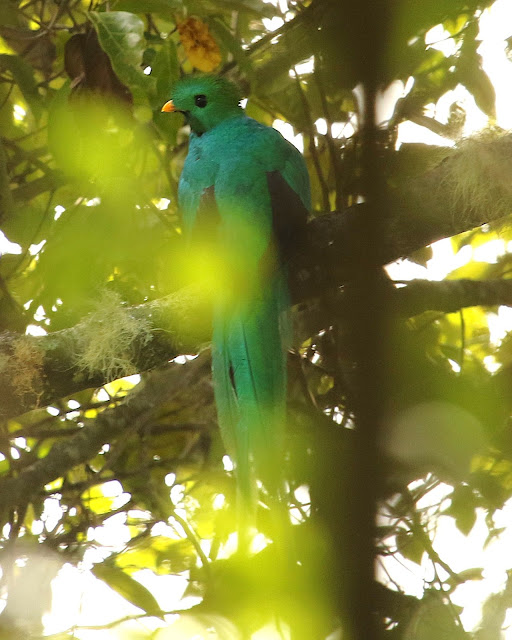 |
| Resplendent Quetzal - PN Los Quetzales, Costa Rica |
This picture gives a better idea of the length of the tail, although strictly it is the upper tail coverts that are elongated. What is less obvious is the bird's red belly, which provides a shocking contrast to the dominant green. To my eyes the head has a slightly reptilian look to it, perhaps belying the bird's ancestry, a trait that unites all five quetzal species. (This is especially evident in the
Golden-headed Quetzal from South America, photographed in Ecuador back in 2014 (below), which lacks the crest that softens the outline of its Central American cousin.)
 |
| Golden-headed Quetzal - Angel Paz reserve, Ecuador (2014) |
Quetzals are trogons, albeit unusual ones. Unlike motmots and toucans, which are confined to the Neotropics, the trogon family has a pan-tropical distribution. Although they have comparatively weak flight and poor dispersal abilities, trogos also pop up in Africa, the Americas and the Indo-Malay tropics, but not Australia. Quetzals, however, are uniquely restricted to the Neotropics.
Research has been done on trogon phylogeny (essentially their family tree) based on DNA evidence, which suggests an American - and specifically Central American - origin to the family (Moyle, 2005; Dacosta and Klicka, 2008). This would require these somewhat non-mobile birds to have crossed the Atlantic at some point, possibly through North America and over a land bridge: a‘high latitude dispersal event’ as Moore puts it. Which begs the question as to whether suitable conditions have ever existed to enable this movement. Could some weird trans-Atlantic rafting have happened instead? It seems unlikely, but such journeys have probably occurred for some plant and reptile species.
Despite its fame, the Resplendent Quetzal is a conservation concern, being classed as 'near threatened' by the IUCN. The main threat, as with so many species, is habitat loss, although this is less of a problem in Costa Rica's protected forests. Direct exploitation for its fabulous plumes may be decreasing, but a new concern has arisen from the range expansion of Keel-billed Toucans. The toucans compete for nest holes and can even prey on the nests of quetzals. Resolving the competing demands of two charismatic species can be a real headache for conservation land managers!
 |
| Keel-billed Toucan - competing with the Resplendent Quetzal for nest sites |
Right - two more birds to go. What could possibly beat the Resplendent Quetzal? Wait and see.
References:
BirdLife International. 2023. Pharomachrus mocinno. The IUCN Red List of Threatened Species 2023: e.T22682727A221577625. https://dx.doi.org/10.2305/IUCN.UK.2023-1.RLTS.T22682727A221577625.en.
DaCosta, J.M. and Klicka, J. (2008). ‘The Great American Interchange in birds: a phylogenetic perspective with the genus Trogon.’ Molecular Ecology, 17(5), pp.1328-1343.
Moyle, R.G. (2005). ‘Phylogeny and biogeographical history of Trogoniformes, a pantropical bird order.’ Biological Journal of the Linnean Society, 84(4), pp.725-738.

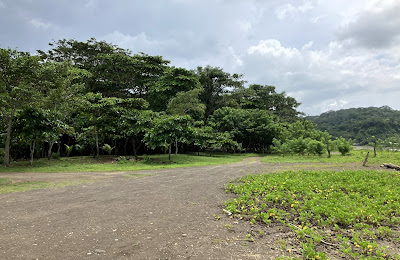

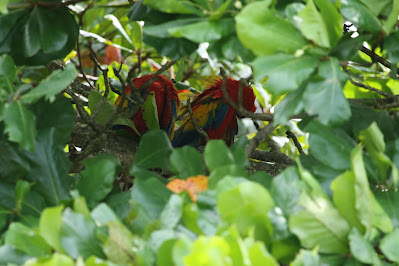







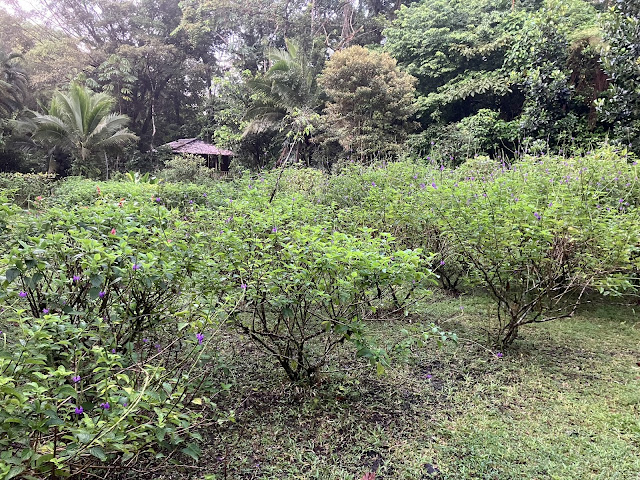
%2015.10.24.JPG)

%20Dota%20Valley%2024.19.24.JPG)





